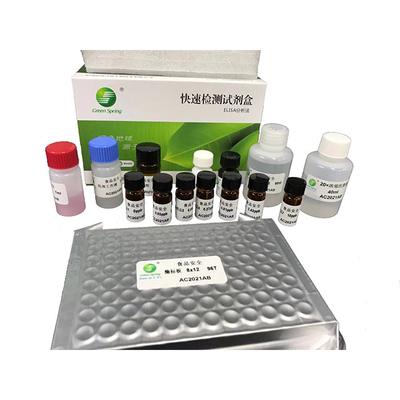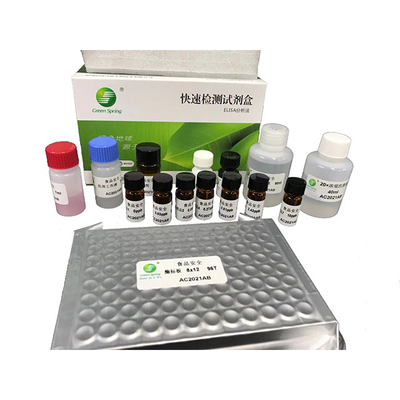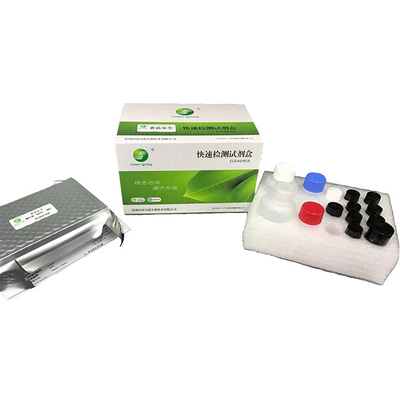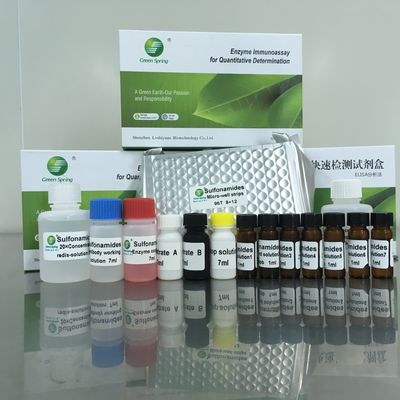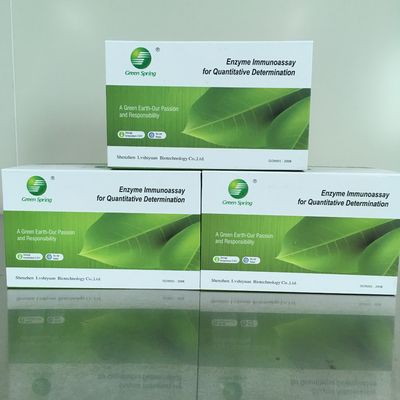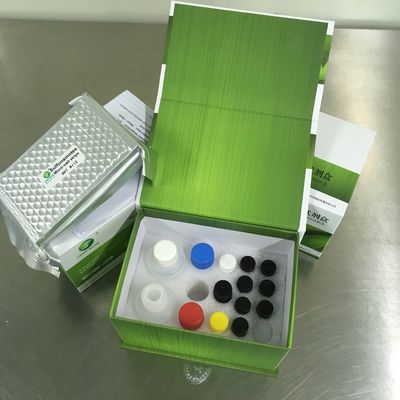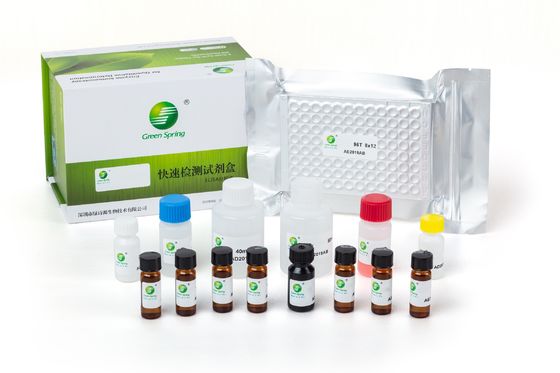|
|
LSY-10053 Tilmicosin ELISA test kit competitive enzyme immunoassay kit for quantitative 96 wells per kit
Product Details:
Payment & Shipping Terms:
|
| Specifications: | 96 Wells/kit | Shelf Life: | 12 Months When Store At 2~8℃ |
|---|---|---|---|
| Incubation Time: | 30min-15min | Sample Performance: | Chicken, Pork |
| Incubation Temperature: | 25℃ |
Tilmicosin ELISA test kit
Catalog No. LSY-10007
1. Principle
This test kit is based on the competitive enzyme immunoassay for the detection of Tilmicosin in the sample. The coupling antigen is pre-coated on the micro-well stripes. The Tilmicosin in the sample and the coupling antigen pre-coated on the micro-well stripes compete for the anti-Tilmicosin antibody. After the addition of the enzyme conjugate, the TMB substrate is added for coloration. The optical density (OD) value of the sample has a negative correlation with the Tilmicosin in it. This value is compared to the standard curve and the Tilmicosin concentration is subsequently obtained.
2. Technical specifications
Sensitivity: 0.5ppb
Incubation Temperature: 25℃
Incubation Time: 20min~10min
Detection limit:
Pork, Chicken 2ppb
Recovery rate
Chicken, Pork 90±30%
Cross-reaction rate:
Tilmicosin 100%
3. Components
|
1 |
Micro-well strips |
12 strips with 8 removable wells each |
|
|
2 |
6× standard solution (1mL each) |
0ppb |
0.5ppb |
|
1.5ppb |
4.5ppb |
||
|
13.5ppb |
40.5ppb |
||
|
3 |
Enzyme conjugate |
7ml |
red cap |
|
4 |
Antibody working solution |
7ml |
blue cap |
|
5 |
Substrate A |
7ml |
white cap |
|
6 |
Substrate B |
7ml |
black cap |
|
7 |
Stop solution |
7ml |
yellow cap |
|
8 |
20× concentrated washing buffer |
15ml |
white cap |
|
9 |
5× Sample extract solution |
100ml |
transparent cap |
4. Materials required but not provided
1) Equipments: microplate reader, homogenizer, nitrogen-drying device, vortex, centrifuge, measuring pipets, and balance( a sensibility reciprocal of 0.01 g), incubator, printer.
2) Micropipettors: single-channel 20-200 µL, 100-1000 µL, and multi-channel 30~300 μl.
3) Reagents: HCl, NaOH.
5. Sample pre-treatment
Instructions
The following points must be dealt with before the pre-treatment of any kind of sample:
1) Only the disposable tips can be used for the experiments and the tips must be changed when used for absorbing different reagents;
2) Before the experiment, each experimental equipment must be checked to be clean and should be re-cleaned if necessary, in order to avoid the contamination which interferes with the experimental results.
Solution preparation before sample pre-treatment
1) 0.2M HCl: take 17.2ml HCl, add deionized water to 1L.
2) 1M NaOH: take 4g NaOH, add deionized water to 100ml.
3) Sample extract solution: the 5×Sample extract solution is diluted with deionized water at 1:4.
5.1 Chicken, Pork
1. Take 2± 0.05g of the homogenized sample into a 50ml centrifuge tube, add 3mL 0.2M HCl, shake for 3min.
2. Add 600ul 1M NaOH and 2.4ml Sample extract solution, shake for 3min, centrifuge at above 4000 r/min at 20℃ for 10 min.
3. Take 50 µL of the up-layer liquid for analysis(note: if there is fat layer after centrifuge, firstly discard fat layer or separate fat layer to take clear liquid to test).
Fold of dilution of the sample: 4
6. ELISA procedures
6.1 Instructions
1 Bring all reagents and micro-well strips to the room temperature (20-25 ℃) before use;
2 Return all reagents to 2-8 ℃ immediately after use;
3 The reproducibility of the ELISA analysis, to a large degree, depends on the consistency of plate washing. The correct operation of plate washing is the key point in ELISA the procedures;
4 For the incubation at constant temperatures, all the samples and reagents must avoid light exposure, and each micro-plate should be sealed by the cover membrane.
6.2 Operation procedures
1. Take out all the necessary reagents from the kit and place at the room temperature (20-25 ℃) for at least 30 min. Note that each reagent must be shaken to mix evenly before use.
2. Take the required micro-well strips and plate frames. Re-sealed the unused microplate, store at 2-8℃, not frozen.
3. Solution preparation: dilute 15 mL of the concentrated washing buffer (20 × concentrated) with the deionized water at 1:19 (1 part of 20X concentrated washing buffer + 19 parts of deionized water), or prepare as quantity needed.
4. Numbering: number the micro-wells according to samples and standard solution; each sample and standard solution should be performed in duplicate, record their positions.
5. Add 50 µL of the sample or standard solution to separate duplicate wells; then add 50 µL enzyme conjugate into each well, at last add 50 µL of antibody working solution into each well. Mix gently by shaking the plate manually, seal the micro-plate with the cover membrane, and incubate at 25 ℃ for 20 min.
6. Pour the liquid, wash the micro-plate with the diluted washing buffer at 250 µL/well for 4-5 times. Each time soak the well with the washing buffer for 15-30 sec, flap to dry with absorbent paper (if there are the bubbles after flapping, cut them with the clean tips).
7. Coloration: add 50 µL of the substrate A solution and then 50 µL of the B solution into each well. Mix gently by shaking the plate manually, and incubate at 25 ℃ for 10 min at dark for coloration.
8. Determination: add 50 µL of the stop solution into each well. Mix gently by shaking the plate manually. Set the wavelength of micro-plate reader at 450nm to determine the OD value. (recommend to read the OD value at the dual-wavelength 450/630nm within 5 min).
7. Result judgment
There are two methods to judge the results; the first one is the rough judgment, while the second is the quantitative determination. Note that the OD value of the sample has a negative correlation with the content of Tilmicosin.
7.1 Qualitative determination
The concentration range (ng/mL) can be obtained from the comparison the average OD value of the sample with that of the standard solution. Assuming that the OD value of the sampleⅠ is 0.2, and that of the sampleⅡis 1.0, while those of the standard solutions are as the followings: 2.005 for 0ppb, 1.643 for 0.5ppb, 1.19for 1.5ppb, 0.67 for 4.5ppb, 0.26 for 13.5ppb and 0.13 for 40.5ppb, accordingly the concentration range of the sampleⅠis 13.5 to 40.5ppb, and that of the sampleⅡ is 1.5 to 4.5ppb.
7.2 Quantitative determination
The mean values of the absorbance values obtained for the average OD value (B) of the sample and the standard solution divided by the OD value (B0) of the first standard solution (0 standard) and subsequently multiplied by 100%, that is,
|
Percentage of absorbance value = |
B |
×100% |
|
B0 |
B—the average OD value of the sample or the standard solution
B0—the average OD value of the 0ng/mL standard solution
Draw the standard curve with the absorption percentages of the standard solution and the semilogarithm values of the Tilmicosin standard solution (ng/mL) as Y- and X-axis, respectively. Read the corresponding concentration of the sample from the standard curve by incorporating its absorption percentage into the standard curve. The resulting value is subsequently multiplied by the corresponding dilution fold, thus finally obtaining the Tilmicosin concentration in the sample.
Using the professional analyzing software of this kit will be more convenient for the accurate and rapid analysis of a large amount of samples. (Please contact us for this software) .
8. Precautions
1. The room temperature below 25 ℃ or the temperature of the reagents and the samples being not returned to the room temperature (20-25 ℃) will lead to a lower standard OD value.
2. Dryness of the microplate in the washing process will be accompanied by the situations including the non-linear standard curves and the undesirable reproducibility.
3. Mix every reagent and reaction mixture evenly and wash the microplate thoroughly, otherwise there will be the undesirable reproducibility.
4. The stop solution is the 2 M sulfuric acid solution, avoid contacting with the skin;
5. Put the unused microplate into an auto-sealing bag to re-seal it. The standard substance and the colourless color former is light sensitive, and thus they cannot be directly exposed to the light.
6. Do not use the kit exceeding its expiry date. The use of diluted or adulterated reagents from the kits will lead to the changes in the sensitivity and the detecting OD values. Do not exchange the reagents from the kits of different lot numbers to use.
7. Discard the colouration solution with any color that indicates the degeneration of this solution. The detecting value of the standard solution 1 (0 ppb) of less than 0.5 indicates its degeneration.
8. The optimum reaction temperature is 25 ℃, and too high or too low temperatures will result in the changes in the detecting sensitivity and OD values.
9. Storage and expiry date
Storage: store at 2-8 ℃, not frozen.
Expiry date: 12 months; date of production is on the box.
Note: If the Vacuum package of microplate has leakage, it is still valid to use, do not affect the test result, be relax to use.
Shenzhen Lvshiyuan Biotechnology Co.,Ltd
D Building, National Biological Industrial Park of Marinelife, No.2 Binhai Road, Dapeng, Shenzhen, 518120 China
Tel. 86-755-28438788
Fax 86-755-28938800
Email: info@lsybt.com
www.lsybt.com
![]()
![]()
![]()
elisa kit
-
LSY-10049 Chlortetracyline ELISA test kit Antibiotic detection
-
LSY-10050 Erythromycin ELISA test kit for milk, honey, tissue
-
LSY-10046 MQCA Olaquindox metabolites ELISA Test Kit ISO certificated
-
LSY-10047 Nitroimidazoles ELISA Test Kit for tissue, honey, milk and egg
-
LSY-10047 Nitromidazoly ELISA Test Kit antibiotic residue Food safety
-
LSY-10047 Nitromidazoly ELISA Test Kit Food testing ISO certificated



